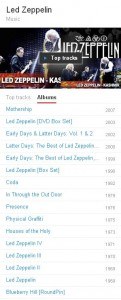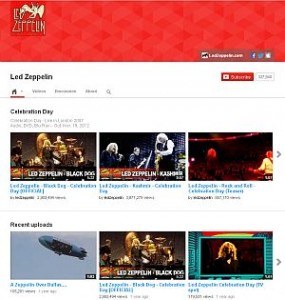Spotify rocked the rockers this week by announcing an exclusive arrangement with Led Zeppelin to carry the group’s entire discography in Spotify’s streaming catalog. Founder Daniel Ek thanked the band for its trust.
But in a broad sense, without fine definitions of “music service,” the deal is neither exclusive nor a first. Led Zeppelin is opulently represented on YouTube with an official channel, every album, many videos of live performances, and a seemingly endless vault of user-created playlists.
The duality of this situation, in which YouTube exists both as a dominating presence in interactive listening, and is ignored, makes that platform a gigantic elephant in the room. That elephant will formally join the party next year with what is reported and rumored to be a subscription music service.
The two questions are: How (in other words, how will Google provide added value to an experience that is already rich with value), and Why (see below).
YouTube Revenue
The “Why” question got fueled yesterday with a report of purported YouTube revenue by eMarketer. The metrics below do not come from Google, but from eMarketer’s analysis of many third-party analytic sources. As directional guidance, eMarketer’s report portrays a platform whose economics dominate the field as much as its content surpasses that of the leading music services.
The headline bullets are:
- $5.6-billion gross YouTube worldwide advertising revenue
- $1.96-billion net YouTube worldwide advertising revenue
- $1.62-billion net YouTube U.S. advertising revenue
Let’s compare Pandora, a public company valued in the $5-billion neighborhood. Pandora earned $410-million gross in 2012, combining its advertising and subscription revenues. Net revenue was negative — the company operates at a loss. Spotify runs in the red too, on gross revenue of $573-million in 2012.
YouTube feels bottomless
The Led Zeppelin comparison illustrates YouTube’s consumer attraction, and the sleeping-giant aspect of its competitive positioning. While Spotify is (justifiably) proud of its deal-making, its neat and orderly presentation of Led Zeppelin albums might feel outdated and old-school when you immerse yourself in YouTube’s oceanic Zeppelin collection. It is not only enhanced by user contributions, but by an official channel which personalizes the band more than Spotify’s formal presentation.
On the other hand, neat-and-orderly is a consumer value — and arguably a YouTube point of failure. When you need to get the Led out, would you rather turn to Spotify’s tidy service, or hack through YouTube’s jungle?
It’s worth remembering that YouTube offers and monetizes more than just music. But as a music service, on a high-revenue platform, YouTube has two overwhelming assets.
The first is audience, particularly young audience. Earlier this year we spoke to Michael Robertson, serial entrepreneur whose current projects include DAR.fm and Radio Search Engine, about YouTube. He noted that YouTube is more representative of streaming trends than Spotify: “My kids don’t do Spotify, Rdio, or Rhapsody. They live on YouTube. The move to a streaming access world is happening faster than we think if you’re using just Spotify as a proxy of the trend. If you consider YouTube, it’s moving much faster.”
The second asset is the catalog.
If Zeppelin’s YouTube presence is impressive, try The Beatles, whose catalog owners are notoriously reluctant to engage in streaming distribution. But on YouTube the Beatles library is jaw-dropping. Albums (some with per-track start points), playlists, TV appearances, and concert footage combine in an astounding vault of seemingly endless dimensions.
The looming new year
2014 could be tectonic for the streaming music industry. It’s not just YouTube’s formal entry as a distinct music platform, whatever that will look like. The field will crowd with new U.S. competition from Deezer, Beats Music, and probably other players. But the awakening of Google’s sleeping giant will be the main Richter-scale event.
In our view, the questions around YouTube’s upcoming service will center on product development. Can Google establish order on the wild-growing YouTube content forest? Will the platform create magnetism among older-than-teen users? Who will pay for YouTube? Will YouTube’s music-only financials resemble its overall balance sheet?
Here’s to the new year.


